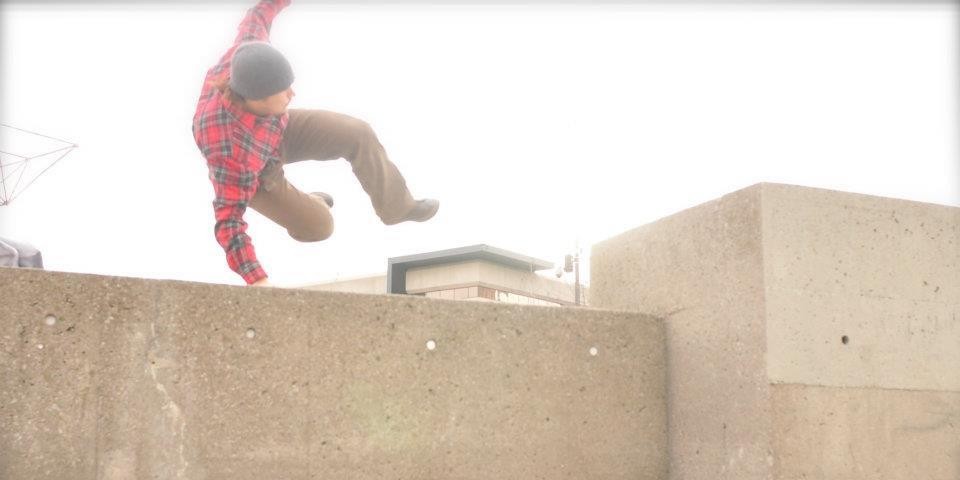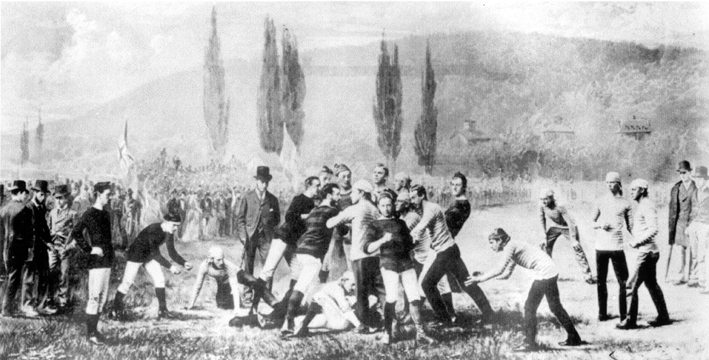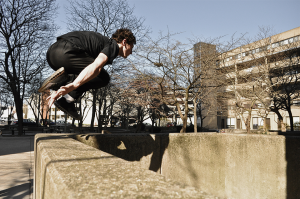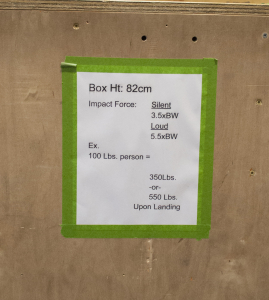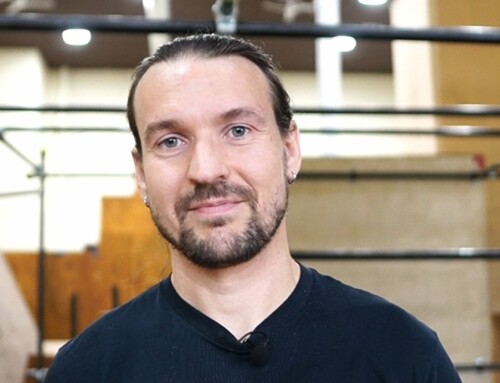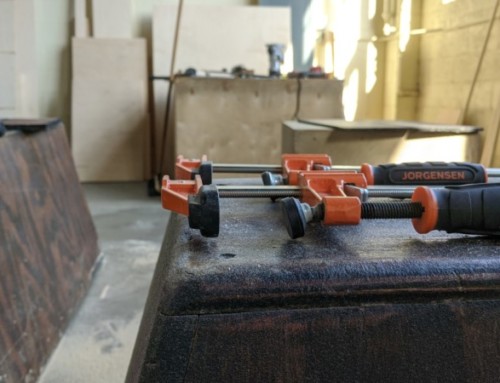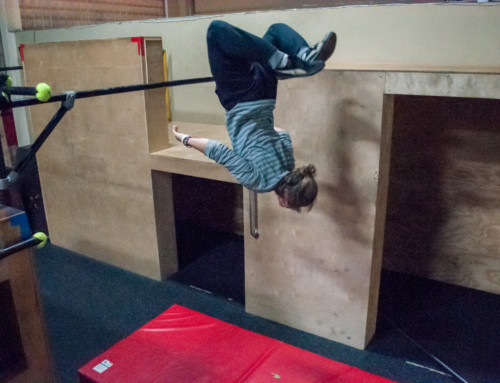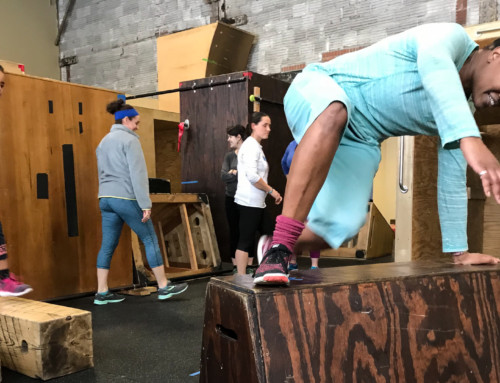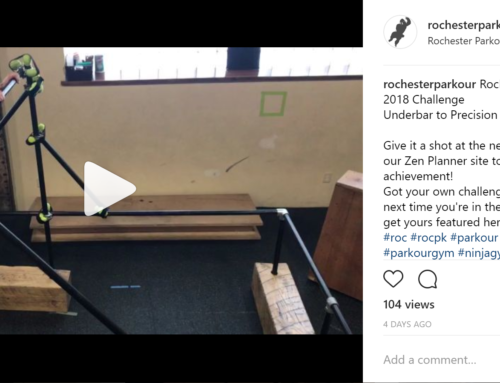a journey into the long-term repercussions of parkour training
Authors: Charles Moreland and Nicole Suchy
Estimated Read Time = 25 minutes
Synopsis
Parkour is a high-impact discipline wherein trainees apply themselves against environmental challenges at speed. We are constantly accessing new and unprecedented heights and pushing the boundaries as to what the human body can do. This article is designed to explore the possibility that maybe we’ve developed into a culture that all-too-often chooses to sacrifice long-term health for short-term gain/fame. The ideas and data presented here begin to formulate our understanding that our landing technique is not magic and we should consider that taking drops higher than hip height, unaltered, could be an unhealthy lifestyle. This article is designed to make you, your friends, and your respective communities think long and hard about whether or not you’re okay with the idea that you might be risking your longevity and what this could mean for parkour coaches and the curriculum they develop.
Historical Parallel: Football
This article is about parkour, but let’s take a minute and discuss a recent evolution of a sport we all know and love: football.
The first game of football happened on Nov. 6th, 1869 and was played by teams made up of Rutgers and Princeton students. Fast forward to 1900, American Football had become a widely popular sport played by many college students and would soon become a national league of professional players in 1920, the NFL. While the sport grew fast for its fun, fast-paced gameplay, there remained an inherent problem…impact. Football is a full-contact sport and relies on one player impacting another player to get them down and stop their forward momentum. Prior to rule changes in 1905 and the entrance of protective equipment, 23 college level players died while playing football.
Even then, safety equipment wasn’t mandatory (and remained that way until 1939). Helmets were an optional piece of equipment and came in a wide variety of styles and shapes. After becoming mandatory, helmets soon evolved as plastics became more widely available and offered extra protection that leather could not. As more research was done on impact, new designs entered the scene like Riddell’s vinyl cushioned helmet that could absorb more impact and offer a more comfortable fit. The evolution of the helmet and other safety equipment continued to improve the risk profile of the sport and helped to almost stop the presence of acute head injury altogether leading into current play.

1940’s Riddell Football Helmet w/ 6 Strap Suspension System & Original Chin Strap
Despite all of this, there was still an elephant in the room: impact, or rather, brain trauma from impact. Sure, players and leagues were putting a lot of time, energy, and money into stopping the acute dangers of cranial collisions and the addition and evolution of the helmet stopped the incidence of major concussions (and death!), but as more research was done, more understanding came to light that brain trauma occurs regardless of the presence of a concussion. In 2010, a panel of researchers presented their data to a committee of referees to which the Head of Officiating for the Big 10 was quoted saying, “There is some really serious concern about the damage that’s done on impact and what happens to the brain.” It was only after this meeting, over a hundred years since wide-spread adoption of the sport, that the new standards and rules for no helmet-to-helmet contact came about. Just recently, in September 2015, the CSTE announced that Chronic Traumatic Encephalopathy (CTE) had been identified in 87 of 91 former NFL players, or 96% of the sample. The study conducted was the largest brain bank study to date and was a twofold increase in the number of confirmed cases of CTE. Basically, if you decide to play professional football, you are nearly guaranteed to develop cognitive brain disorders.
The real take-away from all of this is that it took football, as an organization, over 100 years to fully understand the chronic dangers of their sport despite all their attempts to protect their players along the way; despite the leaps and bounds made in the short-game to prevent acute injuries and death.
With this new perspective for the game of football in mind, you are probably still wondering what this has to do with parkour. While football and parkour may seem like polar opposites, the story presented is a perfect parallel to a problem we’ve been noticing in the parkour community at large. It is our opinion that these hard topics should be discussed sooner, rather than later, so as to learn from football and not make the same mistakes they did. On to parkour!
Parkour Background
We believe that Parkour is the end all be all of a human being’s training. It is the most true form of enhancing all capabilities of the human body, and beyond that comes the creative expression of a traceur’s movements and the thrill of overcoming challenge and exploring our inner potential. Parkour’s progressive nature is addictive, and more often than not, people who find parkour become consumed by it, diving in head first by traveling all over the world, partaking in all day (or sometimes week long) jams, and making videos with friends. Everyone wants that Kong-Pre, that perfect, fluid climb-up, that 10’ gap jump, side-flip pre’s, whatever! We as a community praise those who continually push the envelope and do bigger kongs, bigger jumps, and more explosive movements. One only needs to travel to YouTube and take a glance at the comments section of any major parkour video to see that we are addicted to power. And it’s okay to be! It is a magical feeling watching the athletes of Storm, Farang, Rilla Hops, and others do the things they do.
Since the beginning of the movement, parkour has been plagued by the stigma that it is inherently dangerous and should only be practiced by crazy people. As a community, we’ve made leaps and bounds in the recent years proving to society that we can control and nullify acute injuries. In fact, many parkour gyms have been reporting incidence of injury rates less than 2 or 3 per 1,000 hours trained (The NCAA has reported an 8.1 injuries per 1,000 hours trained in American Football and reported 8.78 and 9.37 injuries per 1,000 hours trained for collegiate gymnasts for male and females, respectively).
While a football player has no ability to tell an opponent NOT to hit him in the knee, the great thing about parkour is that the traceur has full control over their choices. The most valuable tool in parkour is ultimately a practitioner’s common sense! Does this height seem too high to jump from? It probably is! Don’t jump off of it! Bam…broken leg saved! Some people may incorrectly say, “you can jump off of it, but make sure you roll.” There are so many people that walk into the gym with this insane idea that a “parkour roll” (read: jumping off of something tall and rolling when you hit the ground) is some sort of magical technique that makes that drop okay. 10 feet? No problem, bro! I’ll just roll. 20 feet?! Hell yeah, brah! I’ll roll twice! Clearly this is a joke and it’s one we’ve probably all heard at some point. But what if we told you, that we are the same brand of fools? This leads us to our elephant in the room: high-volume impact.
The Elephant in the Room
Just like football, parkour is a high impact activity. Whereas a football player smashes themselves into another player, traceurs are smashing themselves into the ground and into walls or rails. To be fair, we don’t ‘smash ourselves’ so much as we are constantly transitioning levels from low-to-high or high-to-low. We get momentum, we maintain that momentum, and use it to fling our bodies through the air to flow through space. Getting that momentum isn’t the hard part…stopping it is. In comes the parkour landing technique!
Use the toes! Heels up, butt back, spine straight. Make it quiet! These are great cues to help someone understand that the impact they are placing on their joints is damaging and we need to do everything we can to mitigate it. We tell people that the sound of a good landing is silence – that a loud landing means we were lazy and didn’t absorb with our muscles. However, this concept is ultimately flawed. We’ve evolved into a community that believes that just because a landing was quiet and demonstrates the technique we strive for, that we did no damage to ourselves. This is unlikely!

Figure 1. Parkour precision landing; a) Landing phase, b) Cushioning phase.
Despite this plausible damage, the parkour landing technique is certainly better than the alternative. Sports coaches used to teach a toe-heel pattern landing which places significantly more impact on the knees and hips, which is even more preferable to a straight legged landing. While there’s still not much applicable data to parkour specifically, we can pull a lot from the data presented in the last 30 years about drops, ground-reactive forces, and what that data might mean for our longevity. TL;DR? We’re probably destroying our knees. Sorry.
Research Data
This article came about from a desire to present real, whole number facts to the students who wanted to know why they couldn’t just jump off of things. It’s not fun being a landing nazi, having to constantly remind students (especially kids!) that they need to be more ninja-like. “Those drops place a ton of weight on our joints,” we’d say. Most of the time, that’s enough for a student. But what happens when a student wants more? If a student asked that golden question: “How much weight gets placed on our joints?” We’d be stumped!
So we started digging. Of all the articles found, none used any heights over 100cm. 100 cm is 3.2ft – roughly hip height for most adults. The same height of a wall that traceurs vault over like it’s no biggie. The same height that traceurs look at and think, “whatever, I’ll just step off it.”
Let’s get a baseline. What would happen at a certain height if you stepped off and did not bend your knees or try to absorb? We found this amazing article that did just that. Using subjects with an average weight of 64 kg (141lbs for us Americans), this article recorded 4314.10N, 5186.59N, and 6123.48N for 25cm, 50cm, and 75cm respectively. To convert this into laymans terms: a 141lbs person, stepping off a 10” platform and landing straight legged resulted in a force of 939lbs moving through the knee joint. Stepping off a 2.5ft box (75cm) resulted in 1376lbs! That is more than half a ton!
This data obviously means we need to use the mechanics of our legs to save us from these forces. Next up, the toe-heel pattern model. What happens when we try to absorb a little? There were a few different articles to choose from, but this one seemed to be the most concise and used a toe-heel pattern. The highest height measured in this study was 90cm (again, under hip height). The first peak measured (the forefoot touching the ground) reached an average of 5.19x BW. The second peak, or the heel touching the ground, reached 7.82x BW. Again, this is for a height less than hip height. If you weigh 170lbs, using this data, it can reasonably be assumed that when you drop off some smaller sized walls, you would be experiencing a weight of 882.3lbs at initial contact, and 1,329.4lbs at the second! The more we looked at this data and the more we translated the findings into our movement and our students’ movement, the more scared we became. Sure, it could be argued that taking a drop like this every so often probably isn’t that bad, but when you think about your last training session, how many times did you leap off of a wall close to your hip height? Did you land every one of those perfectly? Even so, how many landings sent large amounts of force into your joints over that training session? Volume matters.
Again, it should be said, we don’t teach people to land toe-heel. You’d get yelled at by any traceur or parkour coach worth a damn. We teach forefoot only contact and emulate squatting stance to use as much of the hip musculature as possible. So what happens when we use a parkour landing technique? Luckily, we have a parkour superhero and his name is Damien Puddle!
Damien is doing us a whole lot of good by spearheading some of the most focused scientific studies on parkour techniques. One of his articles has been published and is available for free online. Using a height of 75cm, Damien ran his subjects through three scenarios on force plates – the parkour landing, the parkour roll, and a traditional landing (toe-heel pattern). Mean vertical force (expressed in BW) for the parkour landing was 3.2x BW compared to his 5.2x BW traditional landing.
This is huge for us traceurs. Thanks to Damien, it has been scientifically proven that for traceurs the Parkour Landing Technique is vastly more effective at mitigating impact and shock than any other landing technique studied so far. In this present study, the parkour technique helped the athletes absorb 38% more than the traditional landing. Again, this sounds like a win…We did it, guys! But wait…let’s hold off on the party for a second…
Let’s say that you weigh 170lbs. You drop off of a wall that is 75cm, or rather, 2.5ft. When you hit the ground, you’d feel as if you were 544lbs. On a maximal lift, perhaps you can squat twice your bodyweight or 340lbs. Let’s add 20% to that since humans are stronger eccentrically than concentrically…that means you could lower 408lbs once (and then get stuck and not get up). So in this scenario’s perfect world, there is still 136lbs of force that is finding its way into the knee and hip, compressing these joints together. That is 136lbs still left over every time you jump off of something 2.5ft high. And that assumes you’ve landed every one of those perfectly AND have a 2xBW squat.
Perhaps this logic doesn’t work. Perhaps there is some other work at play that mitigates even more of that force and it’s actually not that bad. Perhaps… Perhaps… Perhaps… But the fact remains: we don’t know!
Implications
The implications that come from all this data is the real focus for us. We’ve established that there is some residual force left over from even low level heights and now we need to figure out what that could mean. In the beginning of this article we drew a parallel to football and outlined how 87 of 91 deceased NFL players have been identified with CTE. If you didn’t click through to the link, you should know that the organization was only able to find this information because those 91 NFL players donated their body to science. Unlike football though, which has more than a 150 year history, parkour has only been around for a short time. In addition to that, long-term studies on joint pathology when searched in conjunction with lifestyle sports (such as gymnastics or triple-jumping) yield no decent results. This reiterates our problem: we have no clue as to what long term complications (if any) could come from lifestyles that incorporate repetitive high-impact landing.
The best we’ve found so far is an article from the 70’s in which rabbits were affixed to a device that would impact only one of their hind legs. At the end of the study, these rabbits were sacrificed and their joints studied for pathology. Here’s point 7 from their research summary:
7) This mechanical model supports the view that cartilage degeneration may be affected by:
(i) the direct effect of repetitive mechanical compression, i.e. fatigue.
(ii) the decrease in mechanical support of the subchondral bone.
The study here demonstrated significant decline in joint and cartilage health for the impacted joints vs the non-impacted joints. Let’s take a look at their method. The researchers affixed the rabbits to a mechanical device that would impact one of their legs with 8.8lbs of force 56 times a minute for an hour a day for 6 weeks. Represented mathematically:
(8.8 x 56) x 60 = 29,568 lbs placed on the joint over an hour’s time
While we realize this is a stretch (obviously there’s a whole mess of inconsistencies when trying to relate this to humans), let’s see what a traceur with a 2xBW squat would need to do within an hour to realize their 29,568 lbs of force:
- 29,568 / 136 = 217.41 perfect 2.5ft landings over an hour (3.2xBW)
- 29,568 / 306 = 96.62 mediocre form 2.5ft landings over an hour (halfway between the 136 and 476 figures)
- 29,568 / 476 = 62.11 poor form 2.5ft landings over an hour (5.2xBW)
- 29,568 / 1,376 = 21.48 straight leg 2.5ft landings over an hour
Again, all of those previous numbers are taking into account the point that the traceur has a 2xBW squat. Most don’t. Putting this information into a typical one hour parkour class, a student would need to average 3.62 perfect 2.5ft landings a minute, or 1.61 mediocre 2.5ft landings a minute, or 1.03 poor form 2.5ft landings a minute to reach the rabbit study’s figure of 29,568 lbs of impact-volume. The rabbit study discovered significant signs of joint and cartilage degeneration in the rabbits after only 3 weeks. Luckily our students do not take an hour long parkour class every single day for 6 weeks. Our average student comes ~2x a week and will theoretically have a decent amount of rest in-between their parkour training.
The saving grace here, it should be reiterated, is that this math most likely won’t add up exactly this way. Think of this section as a worst case scenario: the idea that every pound of force left over from a traceur’s max squat would immediately be presented as joint damage. This exact scenario is highly unlikely, but it does help to gain a much needed perspective: impact adds up real fast! Joints are like tires, every mile put on them will wear them down. A speedster will probably need to replace their tires sooner than a cautious driver, but unfortunately for us, there is no joint store.
Conclusion
The point we’re trying to make here is that while drops and movement related impact is significantly challenging to understand, it can be argued that there is a lot more residual force finding its way into our joints that begs the question, “what if it’s too much?” There’s a lot of variables, and impact occurs so quickly that it’s hard to really develop an understanding as to what all is happening to your body when you land. Were your hips back? Did your heels drop? Were your knees too far forward? How much of the force did you really absorb with your muscles? We aren’t trying to definitively or concretely say how much impact is too much impact or at what height is too high for us to take drops. Instead, we want to place emphasis on the fact that we do not have any conclusive evidence as to what long-term complications could come from this type of repetitive training! Seemingly, we take way more drops than we think we do and many of us have trained into such a high capacity that we don’t give 2.5 or 3ft high drops the respect they deserve.
After having done this research and letting it sink in, we’ve really started to see just how pervasive the presence of impact is on our bodies. When we teach a pop vault, the usual sweet spot height for an adult is 3ft high (~100cm). The drill is to perform a pop vault, and for those who cannot yet do a pop vault, they are devoting a significant amount of mental energy into that technique. Once they get on top of the box, the drill is over. Without fail, we saw student after student jump off of that 3ft high box. Some of them use good technique…others don’t. But what we’re starting to understand is that even if they put 100% of their mental and physical energy into that drop, they are still putting chronic compressive forces on their knees. It can also be guaranteed that none of the students we are looking at can squat twice their bodyweight. Within the span of an 8 minute drill, a student is dropping off that 3ft box more than a dozen times. This article begs the question: what is our responsibility as this student’s instructor? To remind them to land quietly? Or, to keep them from possible irreparable damage by designing the drill to have a required low-impact vault dismount, rather than leaving the decision up to the ill-informed student?
Take a step back and think about your training. How high would you say is too high? How often do you take “big” drops and how often do you take “medium” drops? How often do your students take these drops? It would be such a shame to see the parkour community worldwide, transform into the NFL of the 20th century – turning a blind eye and refusing to talk about a potential problem simply because we didn’t like what it might mean for us and our livelihoods.
In the same way, it would be a real failure for someone to read this article and use it as fuel to shame other traceurs for taking big jumps or performing large-scale power moves. While parkour was founded under the principles of “Be strong, to be useful,” and “To live, and to last,” there are moments in life where destructive decisions are made because life would be boring without that! But in the same way, life cannot only be about making destructive decisions in pursuit of fun or fame or whatever else. This topic is complicated, and we’re not trying to say we have all the answers. What this means for us is that we need to encourage a distinction between parkour as a performance and parkour as a discipline. While watching our favorite YouTube parkour stars is magical and exhilarating, expecting trainers to churn out only ‘10ft kong-pre super athletes’ is not the end-all-be-all of parkour training and those expectations could really harm aspiring adult tracuers and youth alike.
So what can we do to improve the lives of our kids? Pop Warner Football officially decreed that helmet-to-helmet contact is wrong and will not be permitted in games or in practices. For us as parkour coaches, perhaps we should be discouraging big drops or possibly even medium sized drops with our kid/youth students (even if they land them relatively silently). Think about how many traceurs there are with over 10 years of training under their belt. Now imagine that by the time one of our 5 year old students gets to the age at which those people started, they will have been subject to upwards of three times as much impact volume as most other traceurs. It would be amazing if we could say that getting these kids started now was a great thing …but what if it isn’t?
Just because there is no clear or definitive analysis yet as to what chronic damage we may be doing to ourselves, doesn’t mean we should continue business as usual and hope for the best. Hopefully this article can serve as the catalyst that makes athletes, coaches, and students take a good hard look at their training and start asking these hard questions that should be answered sooner rather than later.
Possible Solutions
For us at Rochester Parkour, we’ve decided to make some pretty big leaps (pun intended) toward raising awareness of impact and breeding a new positive atmosphere that encourages everyone to make better decisions when presented with impact. The best visual idea we’ve come up with recently is mass promotion of height awareness by placing informational placards on all our boxes. Here is an easy example:
Take a box, measure it, and make it known to anyone that might be moving through that space what that drop entails. A student, even our young kids, can easily digest this information and begin to understand that 350lbs is a huge number (or whatever their respective numbers would be)…so it becomes more logical that if they jump off that height, they might be doing harm to their bodies. The results are instant! The idea is that we should be creating environments and atmospheres where our students and kids develop the understanding we want them to on their own, rather than being forced into it. Telling a kid that they didn’t land silently and should do better is almost always a negative experience. Presenting information to a kid, encouraging dialog, and having them reason for themselves that they shouldn’t jump off this box because it may hurt them is always a positive experience. Now, our kids naturally choose to do any number of their vault dismounts rather than leaping off!
Lastly, we have also chosen to proactively change the way we present our curriculum to our beginner level students. Some examples of this are emphasis on dismounts instead of drops and taking away precision landings from our adult beginner repertoire. Looking at precisions, we found that students would routinely save bad jumps with good balance, shoving and gesticulating their bodies around in order to save a landing and presumably feel successful. Students underwent countless practice jumps trying to lock in that proper landing technique and we began to see that students were all too willing to accept a mediocre precision and immediately add in more distance.
Now, instead of having beginner students work on precision jumps over and over again, eventually developing the balance, strength and control needed to stick a landing, we found that diligently training stationary balance in a horizontal landing position with focus on squat performance on flat ground and working up to a bar transfers to precision jumps later on without taking much impact. Introducing these students to what we call ‘micro-precisions’ puts emphasis on alignment, reaction time and control from 2 inches away instead of multiple feet. Our adult intermediate students now have a much higher standard and perform precisions with strength and flawless technique upon introducing large scale precisions without having had to rack up quite as many bad jumps to get there (and especially at a time when their bodies were less prepared to handle the associated impact). These are just a few of the ways we as a community have chosen to address our elephant in the room and continue to communicate and educate our members, coaches and associates on this topic.
Call to Action
If you’ve taken the time to get this far, congratulations! We hope that you are now equipped with a better mentality to help promote the positive and healthy nature of parkour training. We’d like to know your thoughts. This topic absolutely requires discussion! Please comment or share this article with your respective communities and encourage dialogue. The more we discuss, the more we learn and the better we can become as a whole. Alternatively, head on over to the Parkour Research facebook page and start commenting with ideas, thoughts, critiques, and share your strategies for saving our students’ (and your own) futures! Unlike American Football, Parkour’s popularity is growing much faster thanks to the internet and social media. Let’s use this tool as a way to also beat football’s adoption of preventative measures and turn Parkour into the ultimate healthy lifestyle that it deserves to be!
**Special Thanks should go out to Damien Puddle who helped give feedback of the data presented. We appreciate you!

-Damien Puddle
Resources
Football Injuries Data from the 2004/05-2008/09 Seasons. Rep. NCAA, n.d. Web. 8 Oct. 2015.

